Updated May 2021
Social media can seem overwhelming, especially when you’re a small business. It’s kind of like extra time you have to put in when you already have so many other things to do.
But with 3.5 billion people using social media, it’s a fast and inexpensive way to reach almost half the world’s population. There’s a reason why you’d be hard-pressed to find a business that isn’t on social media.
You may still be asking yourself “Are the benefits of using social media really worth it?”
In this post, we’ll look at:
- 5 ways social media strengthens your brand
- 7 ways social media allows you to connect with your customers (and potential customers!)
- 12 ways it brings in more people—and revenue
- And 1 way it is a BIG advantage
Let’s get into the first big benefit of using social media.
👀 Are businesses actually fully remote right now? How many are already back in the office? Find out in our State of Hybrid Work report.
It’s a great way to strengthen your brand
Building a strong brand that resonates with your audience can do wonders for your bottom line (more on that later). And taking advantage of the different social media channels out there is the easiest way to do it.
1. Humanize your brand
More and more businesses are using social media to add a human touch to their brand. Essentially, the point of this is to help customers connect to your business on a more personal level.
One way to do this is to add a face to your brand—literally. Showing photos of the people behind your business makes your audience feel like they’re talking to people, rather than to a stuffy company.
So, drop the formalities and let your brand’s personality shine through on social media (but skip this if the nature of your brand requires you to keep things formal, like if you’re a law firm or an insurance provider):
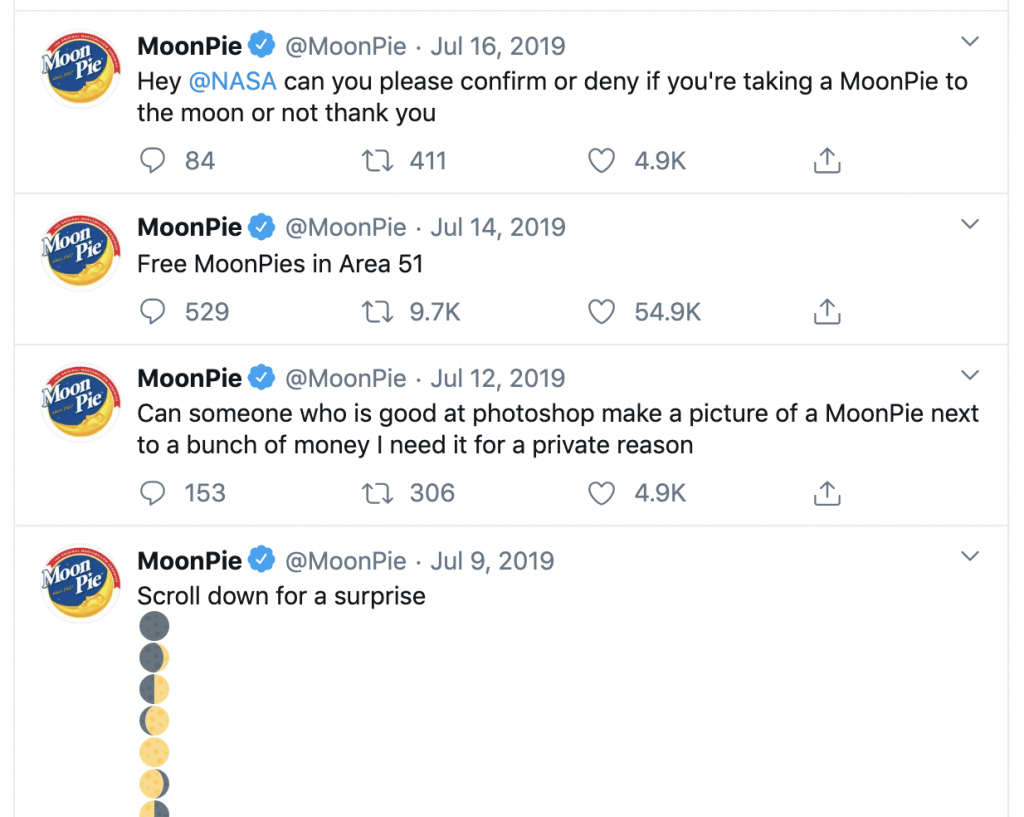
MoonPie, a snack brand, packs a lot of personality in every tweet.
2. Create brand recognition
In a world where 59% of consumers prefer to buy products from brands familiar to them, brand recognition is very important.
Social media allows you to get eyes on your brand much more quickly and easily compared to traditional media, which takes a while to produce your message and get it out there (like radio or TV). By just scrolling through social media on their phones, people can come across your brand multiple times every day—and sometimes, even every hour.
Make sure that when you do get eyes on your brand, all your social media profiles are ready for it. Keeping your profile image consistent across brands will increase your brand recognition while also making your business look more put together. Be sure to also fill out your profile blurbs with useful information that people might want to know at a glance, like when you’re open and how to get in touch.
3. Get people talking about your brand
Social media is, well, social. That makes it an ideal place to facilitate conversations around your brand.
Some of the most natural ways to do this are to:
- Ask your community open-ended questions, like what they’d like to see from your brand. Let them respond to build engagement.
- Give shout-outs to other companies you work with or who are in the neighborhood.
A strong brand is important because it sets you up to have strong relationships with your audience—and your audience is full of potential customers.
Which flows conveniently into the next benefit of using social media.
4. Establish your brand as a thought leader
Every company wants to be recognized by current and potential customers as being at the forefront of their industry. Social media gives you a chance to actively demonstrate your brand’s authority on a topic by curating content for your audience. You can do this by promoting your content on the right social media channels.
But you can’t just post anything. To start becoming a thought leader, you should focus on niche relevant topics in your industry. Make sure that the content you produce is accurate and not misleading and that the content is engaging enough to stimulate active dialog about your brand and the topic.
This can be easier said than done, and the types of posts will need to be tailored to each platform. This can be tough to do with limited characters, such as on Twitter, but you can always link to a blog post on your website.
Another option is to demonstrate your brand’s leadership with content directly on the platform. By using a social media platform like LinkedIn, your brand will have ample space for longer and thought-provoking content. If you can demonstrate real authority as a thought leader in your field, your customers will better trust your business.
5. Manage your reputation
Social media is often a space where communication is unfiltered. On the web, people feel free to speak their minds. Whether good or bad, customers are as likely to share their experiences with those in their offline and online circles. The ability for a bad customer experience to blow up and become viral can be potentially off-putting for any business.
But instead of fearing the fallout of social media, use your direct line of communication to your audience for good. Make use of active social listening to monitor all tags and mentions of your brand on each social media channel.

For small businesses who may not have a full-time social media marketer, employing the right tools to alert your company to any potential problems is vital. Having a communication plan for managing a potential social media crisis will help your business respond with quick action.
Once a problem has been identified, do whatever you can to make it right. With any luck, a satisfied customer will update their followers on the situation. And a clever solution can be spun into a positive story that trends on your social media channels. Not only will you be managing your business’s reputation on social media, but you can actually increase your brand awareness by generating and promoting content at the same time.
Avoiding a crisis is one thing, but also be sure that when a customer posts online about a good experience it doesn’t go unnoticed. When someone has nice things to say about your brand, give them a reply and share the positive vibes with your audience.
It allows you to connect with your customers directly
6. Reach the younger generations
While traditional advertising is still very much alive, research is showing that Gen Z is responding less and less to it. Gen Z refers to those born between the mid- to late-1990s to the early to mid-2010s.
It may sound like Gen Z is too young to be important when it comes to potential customers, but a large part of them are actually in their 20s. (We did the math.) Meaning they’ve been buying from businesses for quite some time now.
And of course, you won’t be limited to Gen Z either. On social media, your business is able to reach customers of all ages.
7. Level up your customer service
As more companies provide customer service on social media, more consumers begin to expect that to be the standard for all businesses. It’s now just a part of the customer experience.
The Sprout Social Index showed that 90% of surveyed customers had used social media to communicate with a brand. That’s no small amount.
While it does involve a time commitment on your end, it’s ultimately a win for both you and your customers. Why?
Social customer service is a great opportunity to connect with your customers one-on-one and make them happy.
For one, you already have a leg up on more traditional forms of customer service that are done through the phone or email. People don’t want to wait on hold for 30 minutes or have one tiny problem stretched out over a few days of emailing back and forth. (Which will probably help you keep up your customer retention rate.)
RingCentral Engage Digital™ can help you manage customer service on all of your social media channels from one place! Social customer service is appealing because response times are quicker and problems get solved faster. So, it’s key that you’re checking for inquiries at least once a day. (Ideally, it’d be much more often than that.)
But what happens when you’re too busy to handle the customer support work? Or maybe there’s a question you may not know the answer to, but someone else on the team does.
This is where a messaging platform can come in handy. You can use it to message your team in real time and work together to get to the bottom of customer questions.
For instance, RingCentral is one that you can use on both a computer and your phone:
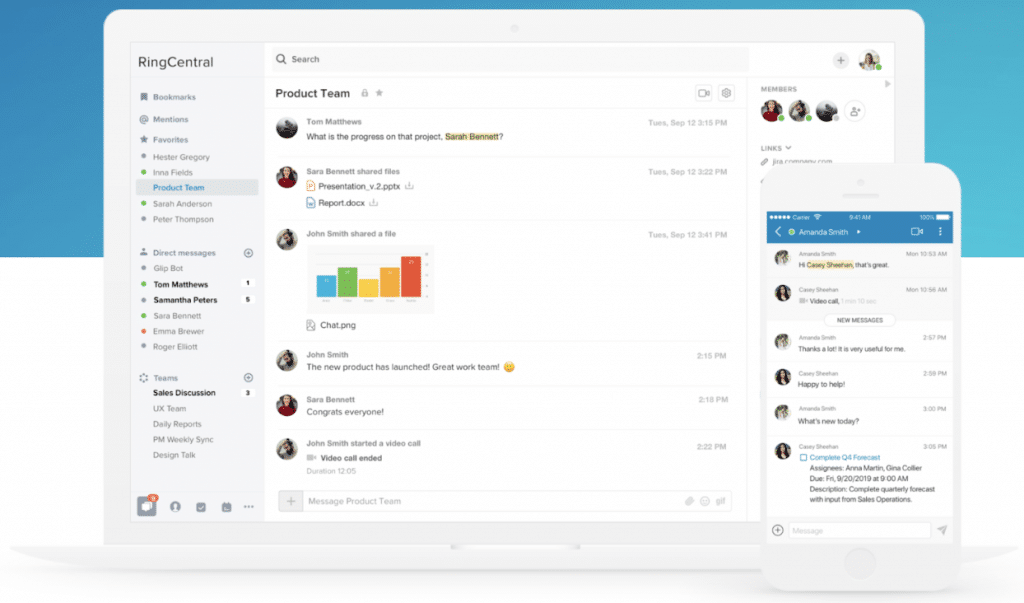
Instant-message each other, share files, and create channels and teams for specific projects—like handling customer service inquiries.
Sometimes, people will ask you a question on the public side of your social media channels (like comments and tweets) rather than through private messages.
This is a great opportunity to not only help someone out, but also show prospects how you interact with your customers. Showing how personable and helpful your brand is will go a long way in making your prospects feel comfortable about trying your product or service out—and making your customers feel good about supporting you.
8. Gather customer feedback the easy way
Having a presence on social media creates an accessible space for customers to share their feedback with you.
Some of this will come through customer reviews and customer support conversations, but some if it will simply pop up in comments and direct messages from your community.
As a bonus, it’s those same comments left on your posts that’ll act as social proof for your brand and your products.
What is social proof? Think of it as testimonials.
Potential customers might be unsure if they want to take the plunge and buy something from your business.
If they see that other people have done the same and had positive things to say about it, it’ll help them trust your brand and your products. In fact, studies show that 92% of online consumers will look at product reviews before making a purchase.
9. Tune in to your audience with social listening
Social listening is basically the act of monitoring conversations on social media that involve your brand specifically or topics relating to your brand (such as keywords and competitors).
Why is it important? It helps you tune in to your audience’s wants and needs, giving you insight about things they like or challenges they may be struggling with. Can you help them solve that problem?
This will help you create content you know your audience actually wants—and that’s social media gold. Plus, you’ll save yourself a lot of guesswork and time.
And if you want to stay one step ahead of your competitors, social media listening helps you keep a pulse on the current trends in your industry, which will keep your content ideas fresh and inspired.
If you want to take things up a notch, there are tools to help. We’re talking dashboards set up with trends that matter in your industry or direct comparisons with your competitors to see who is getting more mentions. You could always start with Mention—it’s free.
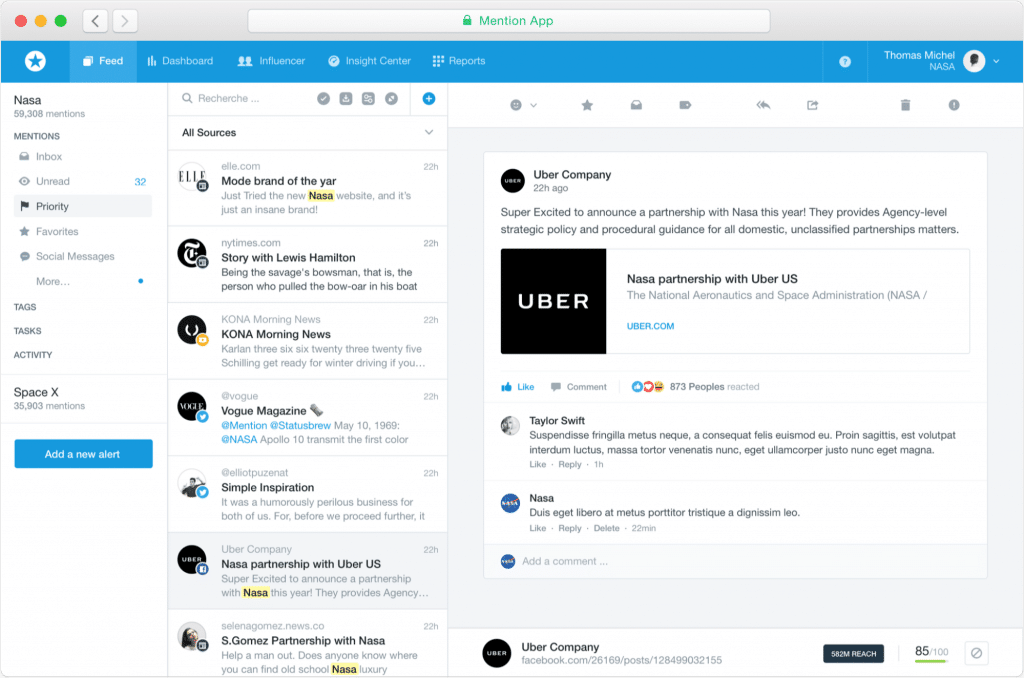
Mention is a social listening tool that helps businesses monitor and analyze conversations happening around their brand and in their industry.
Oh, another thing, you might be thinking that you’ll definitely see all mentions of your brand on social media anyways, because you get notifications for them.
Not exactly.
While for the most part people will tag you when they mention you, it’s not always the case. Sometimes people might just mention your brand by name without actually tagging (@-ing) any of your accounts. Which means you wouldn’t get notifications for these messages.
That’s why it’s important to do active social listening. Every mention of your brand, tagged or not, is an opportunity for you to leave a positive impression of your business.
Make it a habit to do some social listening once a day to keep up to date on what’s happening around your brand and in your industry.
And don’t forget to sync up your social media tools with your company’s communications platform. Having everything streamlined in one place will ensure that all your customer inquiries get answered quickly and that none of them fall through the cracks. You could try something like RingCentral for that.
10. Build brand loyalty
Building brand loyalty is a key task for any thriving business.
What exactly is brand loyalty? It’s when people strongly prefer one brand over its competitors (with or without a good reason).
If you’re wondering what that looks like, think of Coca-Cola and Pepsi.
We all know someone who has drank Coca-Cola all their life and only Coca-Cola. Or someone who specifically requests Pepsi at every restaurant and will refuse to drink Coca-Cola as a substitute. Now that’s brand loyalty.
There are a few ways to go about building brand loyalty. Think of it as making a new friend.
Call us jaded, but it’s usually easier to make friends with those who come with friend perks. So offer special promo codes or discounts to your followers. Using codes that you only give out on social media will give them that aura of exclusivity—and keep your social media audience more engaged.
You can even go beyond promos and discounts and give away freebies. These can be branded merchandise such as shirts or lanyards, or small products from your shop. If you sell a service and not a product, you could offer sampler versions of your services, like a consultation or a trial.
Of course, make sure to stick with inexpensive freebies, especially if you’ll be giving them out often.
Have conversations with these new friends to keep building on those relationships. Use your social media channels to ask open-ended questions your audience can reply to. And don’t forget to reply to them! These personal, meaningful interactions may seem small, but they go a long way.
11. Curate customer content
Brands and customers alike love customer content. You’ve probably seen this before, in the form of photos and stories about your brand shared by your happy customers.
Luckily, social media is full of customer content that comes in steadily without brands having to ask for it.
You can catch wind of these through your tags and mentions. (And if you do social listening, you’ll even catch anything that wasn’t tagged.)
Another way to collect customer content is by playing the hashtag game. Be warned though—many brands fail at this; few succeed. Starting a hashtag is no easy feat, and you never know when something will flop (or go viral). If you do have a brand hashtag that people use (congratulations!), you can also discover customer content just by searching it

Destination British Columbia uses the hashtag #exploreBC to encourage people to share photos of their experiences in BC.

There are tons of photos of tourists and locals alike enjoying all that BC has to offer—a bottomless well of user-generated content that Destination British Columbia could use.
So, now that you have all this customer content, what do you do with it? Share it, of course!
You can share a photo here and there on your channels whenever you need content, or you can use them for a marketing campaign. Just be sure to ask people for permission if you’d like to repost their content.
12. Keep your customers in the know
This is a huge advantage of social media marketing that is easily overlooked.
Social media is the fastest and easiest way to keep your customers and prospects updated on your business. What other immediate way is there to let them know about sales, upcoming events, giveaways, new products and everything else?
Updates through word of mouth, shop signs, and email marketing just don’t have the same ease and reach as social media.
It brings in more people and more revenue
13. Drive traffic to your website, online shop, or blog
Social media marketing is a great help with driving more people to your site.
Your Instagram post showing off new products could bring people to your online shop to have a closer look. The Twitter thread you shared on kitchen-cleaning hacks might encourage people to see if they can find more useful tips on your website.
How do they get there? You guide the way with neat, shortened links.
On Instagram, you can’t include clickable links in the post captions, so throw your website link up in the bio and make sure to tell people it’s there. Twitter, Facebook, and most other social media platforms don’t have that limitation, so you can just include your links at the end of your posts.
Now, when we say links, we don’t mean: www.yourcompany.com/shop/collections/new-arrivals/hey-look/its-the-longest-link-in-the-world.
It’s a bit of an eyesore, and that’s not even close to the worst of them!
That’s why link-shortening tools like Bitly are so useful. They’ll take a long URL and make it more pleasing to the eye by making it shorter.
More traffic is always a good thing. Just keep an eye on what you’re posting and how often, so that you’re not constantly trying to get people to your site. They might start to ignore your posts or even get annoyed about being overly promoted to.
14. Generate audience engagement
With social media, you can source content for your business in a variety of ways. But one of those is to encourage your customers to create it for you! And since 60% of consumers have more trust in posts from other customers, there isn’t a good excuse for your company to ignore user-generated content.
Because you have a direct line to your customers through social networks, you can simply ask them what it is they desire or would like to see in the future. Make sure your customer service team is quick to reply! Use RingCentral Engage Digital to make it easy for your busy team to monitor interactions on all of your customer communication channels, including social media.
And of course, you can also employ social listening tools to monitor what your target audience is talking about when discussing your products and services. With customer knowledge in-hand, you can give your customers what they want, and expect better-performing social media posts as a result.
Another option to employ your customers as part of your content marketing campaign is to create a contest. Your social media department can choose the winning posts and share them with your followers. A giveaway is nice, but there doesn’t even have to be an award for winning. Many users feel rewarded just by seeing their posts shared with a much larger audience than they could reach normally!
You will want to make sure your marketing team comes up with a good hashtag to monitor user activity. Apple has used the #ShotoniPhone hashtag to great success. Besides promoting a large amount of user-generated content, the campaign has helped to solidify the iPhone camera as one of its best features:

15. Go viral (maybe)
Going viral is rare, but without social media it would be nearly impossible.
It starts with your followers liking and commenting on your post. They might even send it to their friends or share it on their own social media channels.
Your content is now exposed to a new audience—and potentially their friends and followers too. As this continues, your content spreads across the internet and eventually, the world.
There’s no one kind of viral post. We’ve seen all sorts of things go viral.
You might remember the ALS Ice Bucket Challenge. It was a social media campaign started to raise awareness for the disease amyotrophic lateral sclerosis.
Here’s how it worked: each person had to dump a bucket of ice water over their head and then challenge a friend to do the same. Eventually everyone was doing it, even celebrities.

Ellen DeGeneres helps Kim Kardashian do the Ice Bucket Challenge.
On the other side of things, there was the “Dumb Ways to Die” video to promote safety around trains. Metro Trains Melbourne made a cute animated video and a catchy tune to go along with it showing a bunch of silly ways to kick the bucket.
The great thing about going viral is that you can get a ton of exposure with relatively little effort. Your audience is doing the work for you.
That being said, your main goal shouldn’t be to go viral—when it does happen, it’s often unexpected and doesn’t happen frequently. And there’s no step-by-step guide or secret formula to it.
Focusing on creating quality content will benefit your brand the most. Think of going viral as an extra bonus.
16. Gain valuable insights
Social media will allow your company to gain valuable insights into many aspects of your business. As mentioned before, active social listening will give you valuable feedback and aid sentiment analysis. This real-time data can be used to spur action almost immediately. When paired with social media analytics tools, it can help your brand improve its content and increase customer engagement.
By gauging the sentiment around your brand, too, you can tailor and adapt your marketing strategies. This will help you widen the net of your social accounts and expand your audience.
You can also look to improve your brand’s image and that of your products and services via customer feedback. By having one-to-one interactions with your customers, you will be able to identify the areas in your business most in need of improvement. And fix common issues with your service before losing customers. Again, by aggregating these interactions with each platform’s analytics tools, you will be able to gain insight to allow for smarter business decisions.
17. Keep an eye on the competition
Any business, large or small, can benefit from information on its competitors. Your company is probably already monitoring your brand’s interactions on its various social media platforms. But what about your competitors?
By using effective social listening, your business can keep up to date with the latest events in your industry. And even more specifically, just what is going on with your rivals.
Everything on social media is open and transparent, so it’s not exactly like you are spying. It’s all there in plain view. To not take advantage would be folly.
You and your team just need to have the right tactics in place. The next time a competitor is in the headlines, your company can find an angle to engage in the conversation.
Let’s say you’re an eCommerce store that sells craft beer directly to the consumer. It’s December, and everyone is trying to get their order in for the holidays.
Thanks to your active social listening tactics, you pick up on a competitor’s recent struggle to fulfill orders in time for Christmas. In real time, your team can act quickly and take control of the conversation. You provide a solution to the spurned consumers by offering not only to deliver in time for the holidays but also offering a promo discount via a link in your social media posts.
In this instance, you would gain new and loyal customers. But you would also be able to take control of a social conversation and increase brand awareness, as well as your authority in the craft beer industry. You could also expect to see many positive social media posts about how your brand gave a superior customer experience.
18. Evaluate your performance
As mentioned previously, effective monitoring of your social media accounts involves tools that help you listen to the conversations around your brand. But you can also easily monitor how well your content is performing.
Each platform supplies its own information and metrics like clicks, likes, shares, and more. This makes it easy to see which posts are performing the best and which ones didn’t strike a chord with your customers.
Using a platform like RingCentral will help you monitor your social channel performance by having all of your platform analytics available in one place. Your contact team can seamlessly move from one task to another from the same screen.
Social media analytics also make it easy to segment your audience. You will get a clearer picture of engagement metrics that help you produce curated content for your different customer bases.
If you are promoting your brand via advertising campaigns on social media, too, you will be able to conduct super easy A/B testing for generating leads and conversions. Use real-time data to hone and craft your advertising for its targeted audience. This optimization will save your business money by increasing the amount of leads gained per ad.
19. Drive conversions
A conversion is when a visitor to your website completes a desired action. That action can be something like completing a purchase or filling out a form.
The exact conversion type will depend on your business goals. Some common conversion types include:
- Online sales
- Email sign-ups
- Quote requests
- Event RSVPs
For example, let’s say you have an in-store event coming up that you’d like to collect RSVPs for. You might post about it on Facebook a few weeks out to let people know what’s happening and to encourage them to register. At the end of your post, you’d include a link that’ll direct them to the event RSVP page on your website. They’ll have a look at the page and maybe register—and there’s your conversion!
The more traffic you have, the more likely you are to get visitors to convert. So by using social media to guide people to your site, you’ll be increasing your conversions.
A simple trick to help make those conversions happen is to add a call-to-action, also known as a CTA.
A CTA is a statement that prompts your visitor to take immediate action. So pretty much exactly what you’d expect from something called a “call-to-action”.
CTAs can look quite different but still be effective. It comes down to what action you want people to take and your brand tone of voice.
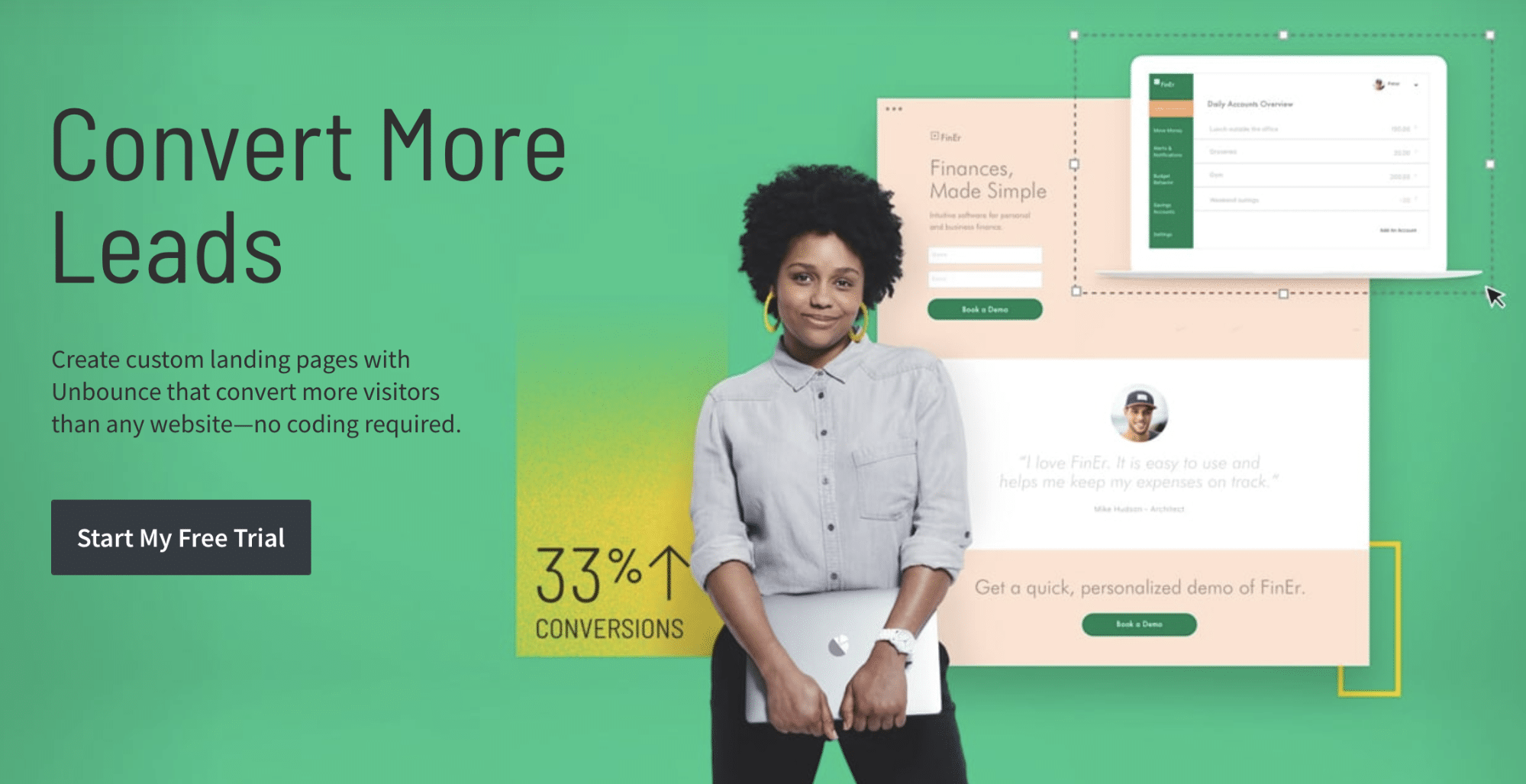
Unbounce prompts their website visitors to take their product for a spin with a “Start My Free Trial” CTA.

Manpacks get creative with their CTA, encouraging people to “Build A Manpack” of their own.
20. Use #s to get more eyes on your brand
A unique advantage of social media marketing is the hashtag integration. We’ve touched on hashtags briefly before, but let’s dive a little deeper into this neat feature.
The hashtag is a simple, yet powerful way to connect people with like-minded interests.
By using existing hashtags or creating your own, you can expand your reach beyond your own community.
They’re easy to use, so why not try it out? Especially when they work so well.
Tweets with hashtags get twice the amount of engagement (clicks, retweets, favorites, and replies) compared to those without.
But how do you pick which ones to use?
First, take a look at the platform you’re posting on to see how many hashtags you should use.
On Twitter, throwing a ton of hashtags into a post clutters your main message and is bad for engagement. One or two hashtags is the way to go, with anything higher dropping your engagement down 17%. Stick to one to two hashtags for Facebook as well (and make sure you optimize your audiences).
Instagram is where you’ll see the most hashtag use. Eleven hashtags is the sweet spot, with a 79.5% interaction rate.
Now, see what hashtags are popular.
Look at what’s trending and see which of those hashtags could apply to your content. They can be location-specific or industry-specific.
For example, there might be a marathon happening in your city. As a major event, it’ll probably have it’s own hashtag. Let’s say it’s #MegaMarathon. You can use that same hashtag in your posts to reach that audience. So if you’re a cafe, you might post something like “In town for the #MegaMarathon? Come by for a cozy coffee with a great view of the track.”
You can also look at what hashtags influencers in your industry are using. If it’s working for them, then it could work for you.
21. Paid advertising options
Getting onto social media and engaging with your customers costs nothing. There are so many benefits to your business from organic social media posting and social listening tactics. However, for some businesses, a paid advertising campaign can be a great way to capitalize on the opportunity afforded by social media marketing.
Each platform will have different advertising capabilities, so it’s best to have a content marketing strategy in place before looking at social media ads. Keep in mind that social media platforms will help your business generate leads from customers who may not find your business otherwise.
Think about who these customers are, and better yet, take a look at your platform’s analytics and find what customer segments you are missing with organic content.
Solutions like Facebook Ads will only reach those who fall into your defined audience. This can include demographics, geography, language, and online behavior. What you get is a higher click rate for your money than standard advertising. With paid ads, the quality of the leads will be improved. By marketing only to the groups you want, you also spend less on your advertising budget.

Take Ooni, for example. Ooni was founded by a husband-and-wife team in 2012. They created a portable pizza oven for households of all sizes. And by using Facebook Ads for Black Friday, they saw spending returns of almost two and half times that from the previous year!
You can maximize your social media ads by making sure potential customers get to a landing page with a call-to-action button in just one click. The chances are that a user who clicks a targeted ad believes they have found what they are looking for. So don’t let the opportunity slip.
22. Retargeting
If you’re an eCommerce retailer, you are well aware of the real problem that is cart abandonment. In fact, according to the Baymard Institute, the average cart abandonment rate across all industries is 70 percent! And it is costing businesses upwards of 18 billion dollars in revenue each year!
No doubt, your eCommerce shop has implemented strategies like promo codes, exit-intent pop-ups, email cart reminders, and more. And all of those tactics can help. But did you stop to think about using social media to tackle those abandoned purchases?
If your business is already campaigning with Facebook Ads, consider using a tracking tool like the Facebook Pixel. Trackers will log a potential customer’s interaction with your website. This will help your social media ads find these customers and remind them about your brand.
The online studio and eCommerce shop, Craftsy, made use of these dynamic ads to retarget their website leavers. They found the campaign to be a great success with a 50 percent increase in incremental sales!
23. Influencer marketing
There are so many different options when it comes to social media best practices. Some businesses stand to gain even more from paid advertising that involves social media influencers. Paid influencer marketing can lift your brand awareness and help you better reach specific segments of your target market.
When it comes to appealing to hip members of your target audience, like Gen Zs, influencers can be the top-of-the-sale funnel hooks for your potential customers. And no place is better for sponsored posts with social media influencers than Instagram.
A third of paid influencer marketing on Instagram takes place in IG stories. At least a quarter of Facebook and Twitter users have made a purchase based on an influencer recommendation. Influencers, too, can have a positive impact on customer spending from all levels of income.
Use these three simple questions to help guide you when finding an influencer to fit your brand:
- Are they relevant?
A relevant influencer will have a similar audience to your target market. Or they will at least have a significant crossover of followers with your brand’s account. It should go without saying, but the content already produced by the influencer should be relevant to your business.
- Do they have reach?
A good candidate for an influencer campaign will be able to reach your target audience, big or small. It’s not always about the largest number of followers but the type that fits your campaign.
- Are they engaging?
Your brand will want to partner with an influencer that receives a lot of engagement from their followers. A micro-influencer with an active but smaller following or 5,000 to 25,000 fans can produce higher quality leads than one with a larger number of followers.
24. Level up your SEO
Search engine algorithms are constantly evolving. When it comes to optimizing your website, it is not an exact science. No doubt, your business has spent time and money crafting on-page SEO for its various online channels. But did you know that social media can help you appear in more relevant searches?
Employing an effective social media marketing strategy can actually boost your rankings in Google and other search engines. It accomplishes SEO improvement indirectly. When your social media posts generate more visits to your blog or eCommerce site, you can increase your brand’s presence via traffic.
Your social media posts will not show up in any kind of SEO improvement. However, research has shown that there is a direct correlation between social media shares and site rank.
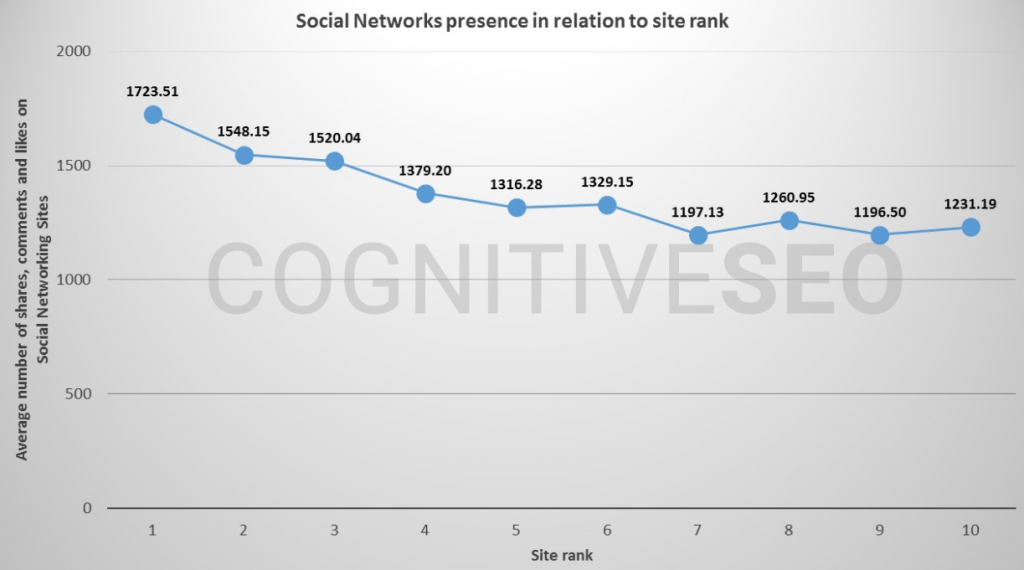
This means that it is important to produce engaging content for your audience. The better curated social media content you produce, the more likely it will be shared. Use your monitoring tools to improve the quality of your business posts. You will increase your reach on social media platforms, but you will be doubling the positive results by also improving your website rank.
Now, for the disadvantages
While the advantages of social media generally outweigh the disadvantages, there are a few things to keep in mind.
You could receive negative feedback
Being on social media opens your business up to all kinds of feedback—good and bad.
There will always be naysayers or people who are looking to damage reputations. But they’re usually few and far between, and it’s not worth giving up all the benefits of social media simply to avoid them.
It can be time-consuming
A strong social media presence is an active one.
You need to post consistently to grow your following and your engagement. Aim for one post a day as a baseline to keep your channels active. If you have time to do more, then go for it!
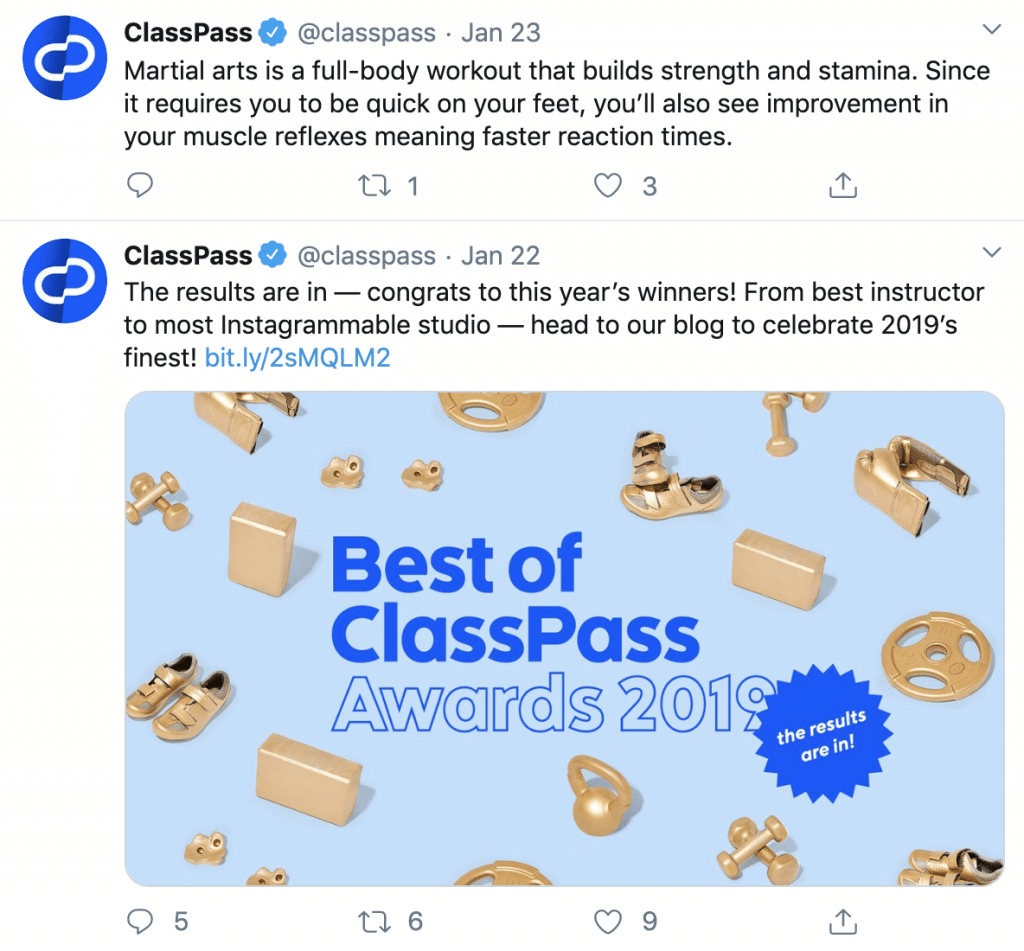
ClassPass keeps their Twitter feed active by posting regularly about new classes and health & wellness.
Just make sure you keep it up. If you post a few times and then go quiet for a few months, you’ll probably see your follower count drop.
In addition to posting regularly, you need to always be engaging with your audience. Liking their comments, answering questions, and being a part of the community you’re building are very important aspects of social media. (And this is why many businesses hire social media managers—it’s tough to do this on your own, especially when you have other things on your plate.)
You can make things a little bit less time-consuming with the help of social media management tools like Buffer, Hootsuite, and Sprout Social.
Measuring results can be difficult
When you put so much time and effort into your social media, you want to know it’s making an impact.
Social media comments, likes, and shares are simple to measure. But at a certain point, you’ll wonder if those things are actually making any difference when it comes to your bottom line. That’s the tricky part.
And you’re not alone. Sixty percent of brands find that their biggest struggle on social media is successfully measuring their return on investment (ROI).
It can be difficult to trace an exact path from someone who sees a social media posts of yours and someone who makes a purchase. But there are things you can track.
When someone makes a purchase on your website, you should be able to see which part of your website they came from using Google Analytics. It tracks the path users take once they’re on your website and can show you how long they spend on each page or where they’re engaging the most.
And when you look at that page on your website, you can see how people got there. Some of those people will have come from your Facebook or maybe your Instagram page.
But before you get into all that, figure out what exactly you want your ROI to be. It could be an increase in home renovation quote requests on your website. Or it could be an increase in sales for your craft store. You can find more details on how to define your social media ROI here.
While it may all seem hazy at times, there are definitely ways to see the payoff from your social media efforts.
Despite the challenges, let’s not forget the biggest benefit of social media:
25. It’s free
Yes, it does take time, which is arguably the most valuable asset we have. But when it comes to cold, hard cash—nada.
Social media platforms are free to join and free to post on. Plus, most of the social media management tools out there have free versions you can use.
So with this many (15!) benefits, why not give social media a go? Learn more about social media best practices here.
Originally published Feb 27, 2020, updated May 22, 2024




